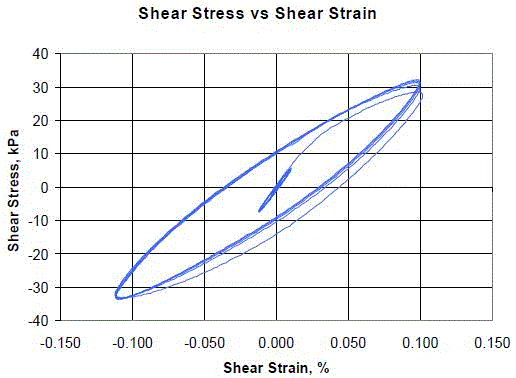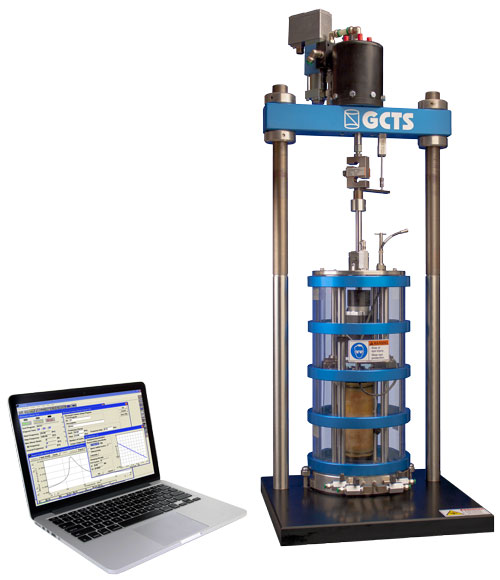Other Shear Tests:
Other Relevant Sites:
Torsional Shear Test
Overview
The torsional shear test is used by geotechnical engineers to determine the shear modulus of soils at medium to high levels of strain. This is done by fixing one end of a solid or hollow cylindrical soil specimen and applying a torsional stress on the other end of the specimen. This test can be performed in conjunction with the resonant column test to determine the full shear modulus versus strain curve for a soil. By understanding the entire shear modulus curve, engineers can determine the response of a soil to various loading conditions, such as construction of a structure (low strain), earthquake loading (medium strain), or a nuclear explosion (high strain).
How is a Torsional Shear Test Performed?
A hollow, cylindrical specimen is placed in a cell and the bottom end is fixed to the bottom platen. Another platen is placed on top of the specimen and an axial load piston is brought in contact with the top platen. Water is forced into the specimen, causing it to become completely saturated, and the confining cell is filled with water. The cell is pressurized and the axial load is slowly and incrementally increased, allowing the specimen to consolidate.
After the specimen has been consolidated, a torsional stress is applied to the top of the specimen, causing the top of the specimen to rotate until a set angle of rotation (up to approximately 20°) has been reached. Then, the torsional stress is reversed, causing the top of the specimen to rotate in the opposite direction past the non-rotated point, until the specimen has rotated to the set angle of rotation has been reached in this direction. This cyclic stress application is performed at frequencies up to approximately 50 Hz while collecting data for the torsional stress and the rotational displacement.
What Does a Torsional Shear Specimen Look Like?
A typical torsional shear specimen is made of soil in either a solid or a hollow cylindrical shape. Specimens can be made with various heights and diameters, as long as height of the specimen is appoximately twice the diameter. Prior to testing, the specimen is wrapped in a non-permeable membrane, which prevents the confining liquid from entering the specimen during testing. A porous stone is placed on the top and bottom of the specmien to allow water saturate the specimen while preventing any soil from breaking off of the specimen.
How are Soil Characteristics Determined?
During the test, the specimen is rotated to a set angle during each stress application. The strain in the specimen can be calculated by multiplying the radius of the specimen by the maximum angle of rotation and dividing by the height of the specimen. However, this means that the strain experienced by the soil in the center of the specimen is different from the strain experienced by the soil on the edge of the specimen. Therefore, an average radial strain must be used. By convention, when testing solid specimens, the radius used to calculate the average shear strain should be equal to two-thirds of the radius of the specimen. When testing cylindrical specimens, the radius used to calculate the average shear strain should be equal to the average of the inner and outer radii of the specimen.
After calculating the shear strain in the specimen at each time interval, a graph can be created with the shear strain on the x axis and the shear stress on the y axis. This should yield a Hysteresis plot, similar to the one shown below.

Torsional Shear Stress-Strain Plot (Courtesy of GCTS)
Once this plot has been created, a line can be drawn through the vertices of the ellipse. The slope of this line is equal to the shear modulus of the soil specimen under the testing conditions at the maximum strain value experienced by the soil during the test. By performing this test with multiple specimens at different strain values, the shear modulus versus strain curve can be determined for a wide variety of strain levels, and when combined with results from the resonant column test, almost the entire shear modulus versus strain curve can be determined for a soil sample.
How Can the Torsional Shear Test be Altered?
The torsional shear test is able to be performed on both solid and hollow cylindrical soil specimens. A solid specimen is much easier to create, but results from this test are less accurate than test results when using a hollow cylinder. This is because the strain experienced by the sample varies along the radius of the specimen, so the strain must be averaged over the entire specimen. Since the mass of the hollow cylinder is much more concentrated than in a solid cylinder, this strain average is more representative of the soil in a hollow test.
In addition to being more accurate, hollow specimen can be used to test higher strain values than a solid specimen. This is because a hollow cylinder has its mass concentrated on the edge of the specimen, so if two specimen were tested under the same loading conditions (same height, outside diameter, axial stress, confining stress, and torsional stress), the hollow cylinder would rotate to a greater angle than a solid cylinder. As such, solid cylinders are more suited for testing smaller strains. However, since hollow specimen are difficult to prepare and are prone to defects, the costs and benefits must be weighed before choosing whether to test a hollow specimen or a solid specimen.
The torsional shear test can also be used to test static loading conditions rather than testing dynamic loading conditions. In this case, the specimen is loaded and consolidated as described previously, but instead of cyclically loading a torsional stress, this stress is applied showly to cause a constant rotation of the specimen. This is continued until failure occurs, or when a constant stress will cause a constant deformation in the specimen. The highest stress the specimen experiences before failure is the shear strength of the specimen. However, when determining the shear strength of a soil sample, it is generally better to use a triaxial test or a direct shear test to obtain more accurate results.
Keywords: Torsional Shear Test — Torsional Shear Tester — Torsional Shear Testing System — Torsional Shear Testing Machine — Testing Instruments — Consolidation — Shear Modulus — Strain — Hysteresis — Shear Strength
© 2016 Geotechnical Consulting and Testing Systems, LLC. All Rights Reserved.

